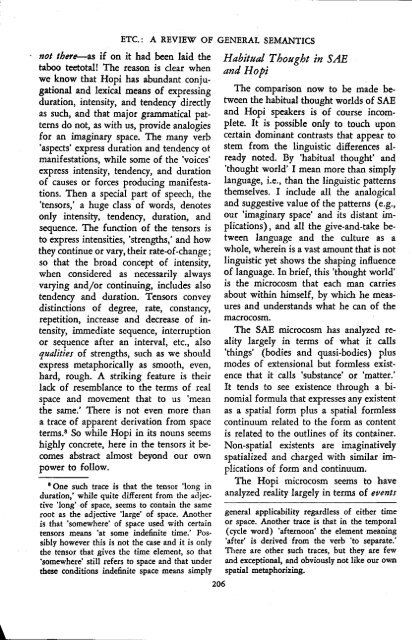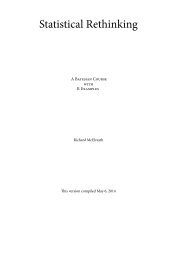the relation of habitual thought and behavior to language
the relation of habitual thought and behavior to language
the relation of habitual thought and behavior to language
You also want an ePaper? Increase the reach of your titles
YUMPU automatically turns print PDFs into web optimized ePapers that Google loves.
ETC. : A REVIEW OF GENERAL SEMANTICS<br />
not <strong>the</strong>re-as if on it had been laid <strong>the</strong><br />
taboo tee<strong>to</strong>tal! The reason is clear when<br />
we know that Hopi has abundant conjugational<br />
<strong>and</strong> lexical means <strong>of</strong> expressing<br />
duration, intensity, <strong>and</strong> tendency directly<br />
as such, <strong>and</strong> that major grammatical patterns<br />
do not, as with us, provide analogies<br />
for an imaginary space. The many verb<br />
'aspects' express duration <strong>and</strong> tendency <strong>of</strong><br />
manifestations, while some <strong>of</strong> <strong>the</strong> 'voices'<br />
express intensity, tendency, <strong>and</strong> duration<br />
<strong>of</strong> causes or forces producing manifestations.<br />
Then a special part <strong>of</strong> speech, <strong>the</strong><br />
'tensors,' a huge class <strong>of</strong> words, denotes<br />
only intensity, tendency, duration, <strong>and</strong><br />
sequence. The function <strong>of</strong> <strong>the</strong> tensors is<br />
<strong>to</strong> express intensities, 'strengths,' <strong>and</strong> how<br />
<strong>the</strong>y continue or vary, <strong>the</strong>ir rate-<strong>of</strong>-change ;<br />
so that <strong>the</strong> broad concept <strong>of</strong> intensity,<br />
when considered as necessarily always<br />
varying <strong>and</strong>/or continuing, includes also<br />
tendency <strong>and</strong> duration. Tensors convey<br />
distinctions <strong>of</strong> degree, rate, constancy,<br />
repetition, increase <strong>and</strong> decrease <strong>of</strong> intensity,<br />
immediate sequence, interruption<br />
or sequence after an interval, etc ., also<br />
qualities <strong>of</strong> strengths, such as we should<br />
express metaphorically as smooth, even,<br />
hard, rough. A striking feature is <strong>the</strong>ir<br />
lack <strong>of</strong> resemblance <strong>to</strong> <strong>the</strong> terms <strong>of</strong> real<br />
space <strong>and</strong> movement that <strong>to</strong> us 'mean<br />
<strong>the</strong> same .' There is not even more than<br />
a trace <strong>of</strong> apparent derivation from space<br />
terms .8 So while Hopi in its nouns seems<br />
highly concrete, here in <strong>the</strong> tensors it becomes<br />
abstract almost beyond our own<br />
power <strong>to</strong> follow .<br />
'One such trace is that <strong>the</strong> tensor 'long in<br />
duration,' while quite different from <strong>the</strong> adjective<br />
'long' <strong>of</strong> space, seems <strong>to</strong> contain <strong>the</strong> same<br />
root as <strong>the</strong> adjective 'large' <strong>of</strong> space . Ano<strong>the</strong>r<br />
is that 'somewhere' <strong>of</strong> space used with certain<br />
tensors means 'at some indefinite time .' Possibly<br />
however this is not <strong>the</strong> case <strong>and</strong> it is only<br />
<strong>the</strong> tensor that gives <strong>the</strong> time element, so that<br />
'somewhere' still refers <strong>to</strong> space <strong>and</strong> that under<br />
<strong>the</strong>se conditions indefinite space means simply<br />
2 06<br />
Habitual Thought in SAE<br />
<strong>and</strong> Hopi<br />
The comparison now <strong>to</strong> be made between<br />
<strong>the</strong> <strong>habitual</strong> <strong>thought</strong> worlds <strong>of</strong> SAE<br />
<strong>and</strong> Hopi speakers is <strong>of</strong> course incomplete<br />
. It is possible only <strong>to</strong> <strong>to</strong>uch upon<br />
certain dominant contrasts that appear <strong>to</strong><br />
stem from <strong>the</strong> linguistic differences already<br />
noted . By '<strong>habitual</strong> <strong>thought</strong>' <strong>and</strong><br />
'<strong>thought</strong> world' I mean more than simply<br />
<strong>language</strong>, i .e ., than <strong>the</strong> linguistic patterns<br />
<strong>the</strong>mselves. I include all <strong>the</strong> analogical<br />
<strong>and</strong> suggestive value <strong>of</strong> <strong>the</strong> patterns (e .g.,<br />
our 'imaginary space' <strong>and</strong> its distant implications),<br />
<strong>and</strong> all <strong>the</strong> give-<strong>and</strong>-take between<br />
<strong>language</strong> <strong>and</strong> <strong>the</strong> culture as a<br />
whole, wherein is a vast amount that is not<br />
linguistic yet shows <strong>the</strong> shaping influence<br />
<strong>of</strong> <strong>language</strong> . In brief, this '<strong>thought</strong> world'<br />
is <strong>the</strong> microcosm that each man carries<br />
about within himself, by which he measures<br />
<strong>and</strong> underst<strong>and</strong>s what he can <strong>of</strong> <strong>the</strong><br />
macrocosm .<br />
The SAE microcosm has analyzed reality<br />
largely in terms <strong>of</strong> what it calls<br />
'things' (bodies <strong>and</strong> quasi-bodies) plus<br />
modes <strong>of</strong> extensional but formless existence<br />
that it calls 'substance' or 'matter .'<br />
It tends <strong>to</strong> see existence through a binomial<br />
formula that expresses any existent<br />
as a spatial form plus a spatial formless<br />
continuum related <strong>to</strong> <strong>the</strong> form as content<br />
is related <strong>to</strong> <strong>the</strong> outlines <strong>of</strong> its container .<br />
Non-spatial existents are imaginatively<br />
spatialized <strong>and</strong> charged with similar implications<br />
<strong>of</strong> form <strong>and</strong> continuum .<br />
The Hopi microcosm seems <strong>to</strong> have<br />
analyzed reality largely in terms <strong>of</strong> events<br />
general applicability regardless <strong>of</strong> ei<strong>the</strong>r time<br />
or space. Ano<strong>the</strong>r trace is that in <strong>the</strong> temporal<br />
(cycle word) 'afternoon' <strong>the</strong> element meaning<br />
'aftei is derived from <strong>the</strong> verb '<strong>to</strong> separate .'<br />
There are o<strong>the</strong>r such traces, but <strong>the</strong>y are few<br />
<strong>and</strong> exceptional, <strong>and</strong> obviously not like our own<br />
spatial metaphorizing .











